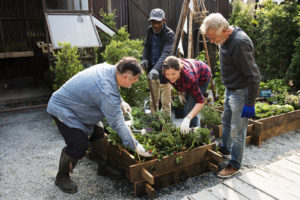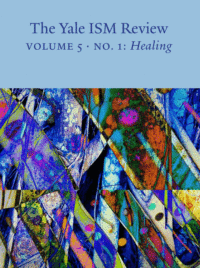Dorothy C. Bass
The four-acre plot on which my congregation’s building stands includes three kinds of gardens:
- Rain gardens—deep-dug hollows filled with native plants, whose roots cleanse the water that drains from this land into an environmentally sensitive watershed near Lake Michigan
- Flower gardens—signs of welcome, bursts of beauty
- A memorial garden—a circle of earth shaded by trees, where human ashes are buried, and where we remember that we were formed by God from the dust of the earth and that to dust we shall return (Gen. 3:19)
On other church properties, in this region and across the country, vegetable gardens flourish, as careful tenders cooperate in the hard work of planting, nurture compost to rebuild depleted soil, and delight in harvests of fresh vegetables to share with their hungry neighbors.
In such gardens, healing is taking place. But this is not healing as it is often imagined in contemporary Western culture, where specialized professionals provide therapies for specific ailments—in this case, ailments afflicting the natural world, such as ecological imbalances or environmental degradation. If seen as corrective therapies, our gardening and similar modest acts of what congregations often call “creation care” accomplish very little. The damage already done to creation is so massive that congregations could recycle every worship folder, compost every ounce of kitchen waste, and eschew every trace of pesticide, while making only miniscule contributions to creation’s repair. Creation’s wounds are so many—forests and soils destroyed, waters poisoned and depleted, species extinguished, and the atmosphere heated to life-threatening temperatures. How could our little gardens even begin to make a difference amid such widespread degradation?
 Small-scale, community-based activities such as these participate in healing of a different kind. In Christian tradition, practices of healing pursue wholeness—a wholeness experienced not through cure, necessarily, but through the restoration of right relationship. In the gardens springing up around churches, congregants are practicing how to live more fittingly within creation; they are rehearsing right relationship, trying it on for size, and increasing their capacity to inhabit it. They remember with their bodies the story of how God created humans to tend and keep a garden—a garden that needs human care just as much as humans need the garden’s produce (Gen. 2:15)—and they make life-giving connections between work, soil, and the needs of those who are hungry. They learn about local waters and strive to protect them. They notice and cultivate beauty. Caring for the simple burial places of those who have died, they remember that they, too, are mortal creatures, formed by God from the earth itself (Gen. 2:7).
Small-scale, community-based activities such as these participate in healing of a different kind. In Christian tradition, practices of healing pursue wholeness—a wholeness experienced not through cure, necessarily, but through the restoration of right relationship. In the gardens springing up around churches, congregants are practicing how to live more fittingly within creation; they are rehearsing right relationship, trying it on for size, and increasing their capacity to inhabit it. They remember with their bodies the story of how God created humans to tend and keep a garden—a garden that needs human care just as much as humans need the garden’s produce (Gen. 2:15)—and they make life-giving connections between work, soil, and the needs of those who are hungry. They learn about local waters and strive to protect them. They notice and cultivate beauty. Caring for the simple burial places of those who have died, they remember that they, too, are mortal creatures, formed by God from the earth itself (Gen. 2:7).
All this is necessary because beneath creation’s visible wounds lies another wound: a great tear in the fabric of creation caused by the self-separation of human creatures from the nonhuman members of creation, and from one another in the human family. Humanity’s most privileged members have pursued their own desires with little regard for the well-being of the rest of creation, including the marginalized people most affected by environmental degradation. Perhaps the most important practices of healing that a congregation can undertake involve forming the faithful to live toward the healing of this wound, this great rending which is at the root of so much damage to the earth and its most vulnerable members. The first signs of such healing may appear in congregants themselves, even if the initial impact of their actions on the physical world is small. But as they rediscover their lost, yet rightful, sense of belonging in creation, they gain the freedom to live responsibly and act boldly beyond the congregation. In other words, a community’s apparently modest forms of creation-care contribute to freeing its members from harmful patterns of behavior and form them to participate, deliberately and generously, in the massive economic and cultural transformations that are required to avert climate catastrophe.
In Laudato Si’, an encyclical letter addressing the environmental crisis, Pope Francis provides a trenchant analysis of the sources and effects of environmental degradation, and he advocates numerous specific remedies to be undertaken on a global scale. Undergirding the encyclical as a whole, however, is the urgent summons to recognize, embrace, and love the earth as “our common home”—a home that is “common” to an “us” that includes every natural element and all living creatures, especially those who suffer the effects of poverty and environmental degradation. Drawing on the spiritual insight of St. Francis of Assisi, the pope writes that “if we feel intimately united with all that exists, then sobriety and care will well up spontaneously,” creating in us “a refusal to turn reality into an object simply to be used and controlled.”[1]
Each congregation worships God in a unique location on creation’s dazzling, complicated map.
But how can we arrive at a sense of being intimately united with all that exists? For Christian congregations, it is worship that most fully unites them with all that exists. To affirm this is not to co-opt liturgy as a means to the end of ecological renewal. Rather, it is to highlight affirmations that already shape Christian liturgies and the people who participate in them. When we gather to worship God, the Creator, Redeemer, and Sustainer of all that is, we are invited into right relationship with God and all that God has made. The specific words and movements through which this grand reception of right relationships is expressed differ from one liturgical tradition to another. But in this context, creation is sung about, and prayed for, and reimagined, not at all as an object to be used and controlled, but rather as a beloved home to be inhabited with gratitude, joy, and care.
Each congregation worships God in a unique location on creation’s dazzling, complicated map. Often, it’s this location—its distinctive beauty, its specific environmental hazards—that brings certain elements of the liturgy into special prominence. In my congregation near Lake Michigan, for example, our landscape is wet and green—a good thing—but it is also subject to frequent floods caused by unwise development, and its streams and lakes have absorbed poisons released by harmful industrial processes. What does it mean to pray over water, on this landscape? Prayers for the healing of imperiled waters are sometimes included in our prayers of intercession, but another prayer—a prayer of thanksgiving—brings the living water on which we depend into worship in a way I find especially powerful. Offered while water is poured into the font during a baptismal service or at the beginning of some services of Holy Communion, this prayer praises God for water and all the blessings water has borne.
Joined to Christ in the waters of baptism
we are clothed with God’s mercy and forgiveness.
Let us give thanks for the gift of baptism.
Holy God, holy and immortal, holy and mighty,
you are the river of life,
you are the everlasting wellspring,
you are the fire of rebirth.
Glory to you for the waters of the earth:
Glory to you for Sand Creek and Lake Michigan,
for rainfall and wetlands,
for Silver Lake and the Kankakee River,
for the Mississippi, the Gulf of Mexico, and all the earth’s oceans,
and for the life that flourishes in and near these waters.
Praise to you for your saving waters:
Noah and the animals survive the flood.
Hagar discovers your well.
The Israelites escape through the sea,
and drink from your gushing rock.
Namaan washes his leprosy away,
and the Samaritan woman will never be thirsty again.
At this font, holy God,
we praise you for the water of baptism
and for your Word that saves us in this water.
Breathe your Spirit into us and into all creation.
Illumine our days.
Enliven our bones.
Dry our tears.
Wash away the sin within us,
and drown the evil around us.
Satisfy all our thirst for your living water,
Jesus Christ, our Savior,
who lives and reigns with you and the Holy Spirit,
one God, now and forever.
Amen.[2]
 Here the waters of the world and of my local watershed flow together, and God is at work in them all. God is also at work in and for those who pray these words today, as God has been at work in and on behalf of their forebears, bringing liberation and redemption. Prayers such as this one invite worshipers into intimate union with God and all creation. When I pray using words such as these, I realize that my baptism immerses me in Christ and, at the same time, immerses me in God’s watery creation, from which I cannot be separated and live.
Here the waters of the world and of my local watershed flow together, and God is at work in them all. God is also at work in and for those who pray these words today, as God has been at work in and on behalf of their forebears, bringing liberation and redemption. Prayers such as this one invite worshipers into intimate union with God and all creation. When I pray using words such as these, I realize that my baptism immerses me in Christ and, at the same time, immerses me in God’s watery creation, from which I cannot be separated and live.
In a congregation located on a desert landscape, other natural elements might open more stirring paths into connection with creation. At the United Church of Santa Fe, New Mexico, Pastor Talitha Arnold and her congregation have attended closely to the dry land in which they dwell, asking how the desert shapes them and draws them close to God and all creation. Arnold has spoken of how alien the hymns of transatlantic culture sound in that context. “Field and forest, vale and mountain, flow’ry meadow, flashing sea, chanting bird and flowing fountain”— where are the arroyos, the red rocks, and the prickly pears? This congregation, Arnold has written, needs “a liturgical life that connects the people to the desert around them,” and it has developed one.[3] A large piece of fiber art hanging at the front of the worship space depicts a landscape of dry hills, layered in browns and tans and reds; in the foreground is a native plant, bent by desert winds—it is their Tree of Life.[4] The congregation’s “Whole Earth Covenant” commits the people of United Church of Santa Fe, corporately, to “develop through worship, education, and our interpretation of Christian traditions, a spirituality that reflects our home in the desert and our respect for all of creation in all its diversity.” As individuals they have pledged to change their lifestyle and consumption patterns, engage with issues threatening the planet, and to “recognize that as desert dwellers we have a special responsibility to protect its delicate ecosystems, and not least, to wisely use water which is precious to all life.”[5]
Even while living into the kind of healing that bears witness to wholeness and right relationship, I long and hope for the other kind of healing as well—that is, for a cure, a redress of environmental injury and illness, so that there might be a life-giving climate, plenty of clean water, and soil that supports growth. Efforts to repair creation’s material wounds will require economic, technological, and cultural changes in which Christians join with people of every nation, class, and creed.
In congregations, members can encounter many entryways into the urgent, indispensable work that lies before the entire human family at this crucial juncture in the history of the planet. Some may start in the garden, others on an altar guild charged with bringing creation’s beauty into worship or on a building committee trying to lower the heating bill. Some may work on a hospitality team committed to stopping the use of disposable cups and utensils. Others may attend a presentation on Laudato Si’ or read a denominational policy paper on the environment. Most important, all will be renewed, in worship, in the awareness that they themselves belong to Christ, through whom all things have been created and in whom all things hold together (Col. 1:16–17). And at the end of the liturgy, they will be sent out into the world to love and serve God and the world that God has made.
Congregations whose members hear the call to participate in the healing of creation can find rich resources to support deeper engagement. GreenFaith, Interfaith Partners in Action for the Earth (www.greenfaith.org) and Blessed Tomorrow (www.blessedtomorrow.org), an interfaith advocacy and education organization supported by many U.S. religious bodies, provide material for further learning and action to address climate change, as well as links to numerous denominational programs and civic organizations working for environmental justice. Anne and Jeffery Rowthorn’s critically acclaimed book, God’s Good Earth: Praise and Prayer for Creation (Liturgical Press, 2018), contains an abundance of ecumenical resources for prayer, reflection, and worship.
An increasing number of congregations, some of them environmental leaders in their communities, heartily collaborate with people of different faiths, or none, to renew the common home they share. For example, during the Global Climate Strike on September 20, 2019, dozens of Twin Cities congregations joined a historic youth-led protest at the state capitol. Afterwards, some protesters gathered at Our Saviour’s Lutheran Church in Minneapolis for prayer, reflection, and conversation about next steps. Such participation in a global movement for change reflects this congregation’s ongoing concern for creation’s repair, a concern that finds vivid articulation in OSLC’s regular worship life as well. This community often gathers around the large stone baptismal font at the entrance to the nave; its basin, flowing with living water, is carved in the pattern of the Mississippi River, which flows just a few blocks away.
Throughout what is likely to be a long and difficult struggle to renew the health of this planet, people who are formed in practices of healing within embodied, worshiping Christian communities will continue to be nourished and emboldened in communion with God, humankind, and all that is. Even when damage seems overwhelming, we will sing psalms that help us to see creation in its God-given wholeness, a wholeness of which we ourselves are part and to which we fully belong. We will praise God for creation’s wonderful variety and complexity, in song and image and words. We will pray for creation—both the parts that brim with beauty, and the parts whose wounds make us weep. And we will be sent out, filled with longing for the well-being of all these parts of creation, and with awareness of our kinship to them within our common home.

 Dorothy C. Bass is a practical theologian and church historian. During twenty-five years as director of the Valparaiso Project on the Education and Formation of People in Faith, a Lilly Endowment project on how greater attention to practices might contribute to the renewal of Christian congregations, theology, and life, she wrote, edited, or coedited more than a dozen books, including Practicing Our Faith, Receiving the Day, and Leading Lives That Matter. She is now Senior Fellow in the Lilly Fellows Program at Valparaiso University.
Dorothy C. Bass is a practical theologian and church historian. During twenty-five years as director of the Valparaiso Project on the Education and Formation of People in Faith, a Lilly Endowment project on how greater attention to practices might contribute to the renewal of Christian congregations, theology, and life, she wrote, edited, or coedited more than a dozen books, including Practicing Our Faith, Receiving the Day, and Leading Lives That Matter. She is now Senior Fellow in the Lilly Fellows Program at Valparaiso University.[1]Pope Francis, Laudato Si’: On Care for Our Common Home, no. 11.
[2] Adapted from Evangelical Lutheran Worship (Minneapolis: Augsburg Fortress Press, 2006), 71. I have written this adaptation, following a pattern of naming local waters that I have heard in my own and other congregations.
[3] Arnold’s description of the congregation’s liturgical needs and her comment on hymns are from her contributions to the Yale ISM Congregations Project, https://ismcongregations.yale.edu/united-church-santa-fe-santa-fe-nm (accessed September 9, 2019).
[4] Larry L. Rasmussen, Earth-Honoring Faith: Religious Ethics in a New Key (New York: Oxford University Press, 2013), 367.
[5] United Church of Santa Fe Whole Earth Covenant (Adopted by vote of the whole Congregation on June 21, 2009), http://www.unitedchurchofsantafe.org/wp-content/uploads/2014/07/United-Whole-Earth-Covenant.pdf (accessed September 9, 2019).
—
Recommended Citation: Bass, Dorothy C. (2019): “Congregations and the Healing of Creation,” The Yale ISM Review: Vol. 5: No. 1, Article 4. Available at https://ismreview.yale.edu
